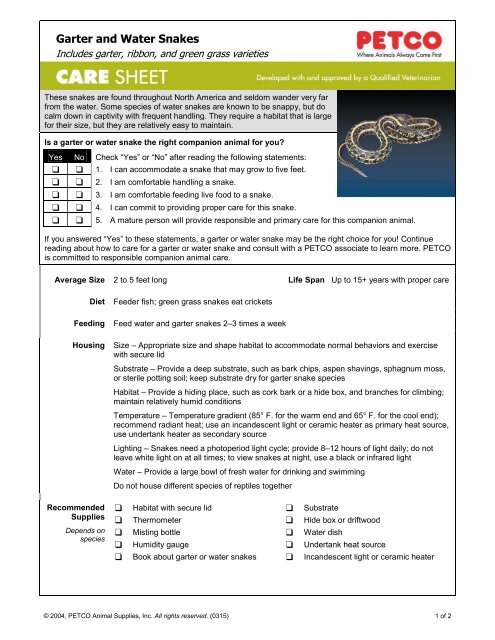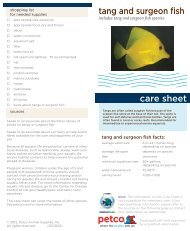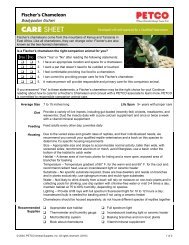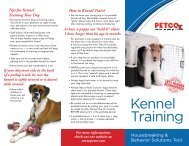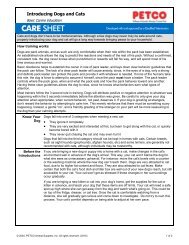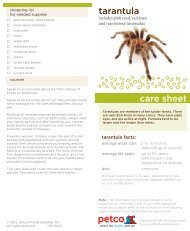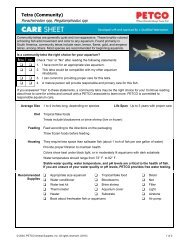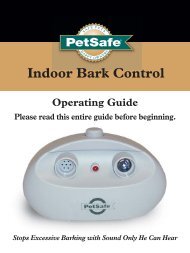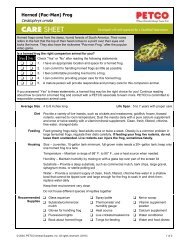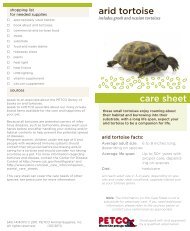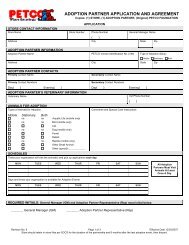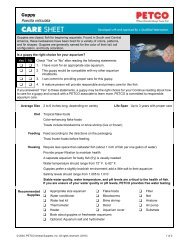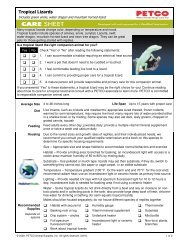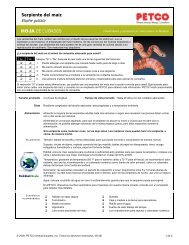Garter and Water Snakes - Petco
Garter and Water Snakes - Petco
Garter and Water Snakes - Petco
Create successful ePaper yourself
Turn your PDF publications into a flip-book with our unique Google optimized e-Paper software.
<strong>Garter</strong> <strong>and</strong> <strong>Water</strong> <strong>Snakes</strong>Includes garter, ribbon, <strong>and</strong> green grass varietiesThese snakes are found throughout North America <strong>and</strong> seldom w<strong>and</strong>er very farfrom the water. Some species of water snakes are known to be snappy, but docalm down in captivity with frequent h<strong>and</strong>ling. They require a habitat that is largefor their size, but they are relatively easy to maintain.Is a garter or water snake the right companion animal for you?Yes No Check “Yes” or “No” after reading the following statements:❑ ❑ 1. I can accommodate a snake that may grow to five feet.❑ ❑ 2. I am comfortable h<strong>and</strong>ling a snake.❑ ❑ 3. I am comfortable feeding live food to a snake.❑ ❑ 4. I can commit to providing proper care for this snake.❑ ❑ 5. A mature person will provide responsible <strong>and</strong> primary care for this companion animal.If you answered “Yes” to these statements, a garter or water snake may be the right choice for you! Continuereading about how to care for a garter or water snake <strong>and</strong> consult with a PETCO associate to learn more. PETCOis committed to responsible companion animal care.Average Size 2 to 5 feet long Life Span Up to 15+ years with proper careDietFeedingHousingFeeder fish; green grass snakes eat cricketsFeed water <strong>and</strong> garter snakes 2–3 times a weekSize – Appropriate size <strong>and</strong> shape habitat to accommodate normal behaviors <strong>and</strong> exercisewith secure lidSubstrate – Provide a deep substrate, such as bark chips, aspen shavings, sphagnum moss,or sterile potting soil; keep substrate dry for garter snake speciesHabitat – Provide a hiding place, such as cork bark or a hide box, <strong>and</strong> branches for climbing;maintain relatively humid conditionsTemperature – Temperature gradient (85° F. for the warm end <strong>and</strong> 65° F. for the cool end);recommend radiant heat; use an inc<strong>and</strong>escent light or ceramic heater as primary heat source,use undertank heater as secondary sourceLighting – <strong>Snakes</strong> need a photoperiod light cycle; provide 8–12 hours of light daily; do notleave white light on at all times; to view snakes at night, use a black or infrared light<strong>Water</strong> – Provide a large bowl of fresh water for drinking <strong>and</strong> swimmingDo not house different species of reptiles togetherRecommendedSuppliesDepends onspecies❑ Habitat with secure lid ❑ Substrate❑ Thermometer ❑ Hide box or driftwood❑ Misting bottle ❑ <strong>Water</strong> dish❑ Humidity gauge ❑ Undertank heat source❑ Book about garter or water snakes ❑ Inc<strong>and</strong>escent light or ceramic heater© 2004, PETCO Animal Supplies, Inc. All rights reserved. (0315) 1 of 2
<strong>Garter</strong> <strong>and</strong> <strong>Water</strong> <strong>Snakes</strong>Includes garter, ribbon, <strong>and</strong> green grass varietiesNormalBehavior <strong>and</strong>InteractionHabitatMaintenanceGrooming<strong>and</strong> Hygiene<strong>Garter</strong> or water snakes are mainly diurnal (awake during the day), but are often active in theearly eveningSome species are extremely active compared to other snakesChange water dailyThoroughly clean the tank at least once a week: set snake aside in a secure habitat; scrub thetank <strong>and</strong> furnishings with a 3% bleach solution; rinse thoroughly with water, removing all smellof bleach; dry the tank <strong>and</strong> furnishings; <strong>and</strong> add clean substrate<strong>Garter</strong> <strong>and</strong> water snakes will regularly shed their skin; ensure humidity of habitat is atappropriate level to allow snake to shed properlyTo facilitate shedding, provide a large container allowing snake to immerse entire bodyAlways wash your h<strong>and</strong>s before <strong>and</strong> after touching your snake or habitat contents to helpprevent Salmonella <strong>and</strong> other infectious diseasesSigns of aHealthy AnimalCommonHealth IssuesRed Flags Clear eyes (except when shedding) Active <strong>and</strong> alert Clear nose <strong>and</strong> mouth Eats regularly Body is rounded <strong>and</strong> full Healthy skinHealth Issue (alpha) Symptoms or Causes Suggested ActionDermatitisRespiratory DiseaseStomatitisTicks <strong>and</strong> MitesBlisters. Rapid shedding caused byan unclean habitat or one that is toocold or damp.Labored breathing. Mucus in mouthor nostrils. Can be caused by ahabitat that is too cold or damp.White, cheesy substance in themouth; loss of teeth <strong>and</strong> appetite.Parasites on skin. Can transmitdisease. Wrinkled or rubbed skin Vomiting Discharge in nose or mouth Lethargy Abnormal feces or urine Decreased appetiteClean the cage <strong>and</strong> lowerhumidity. Consult your exoticanimal veterinarian.Keep snake warm <strong>and</strong> dry.Consult your exotic animalveterinarian.If untreated, can be fatal.Consult your exotic animalveterinarian.Consult your exotic animalveterinarian.If you notice any of these signs, please contact your exotic animal veterinarian.SourcesA Petkeeper’s Guide to Reptiles & Amphibians by David AldertonKeeping <strong>and</strong> Breeding <strong>Snakes</strong> by Chris MattisonThe Proper Care of <strong>Snakes</strong> by Armin GeusNote: The information on this Care Sheet is not a substitute for veterinary care. If you need additionalinformation, please refer to the above sources or contact your veterinarian as appropriate.2 of 2 SKU 926795 © 2004, PETCO Animal Supplies, Inc. All rights reserved. (0315)


